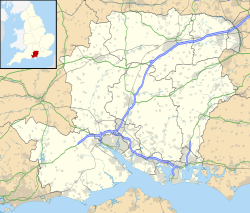Hurstbourne Tarrant
Village and civil parish in Hampshire, England From Wikipedia, the free encyclopedia
Hurstbourne Tarrant is a village and civil parish in Hampshire, England.[2][3] It lies to the north of the county in the Test Valley.
| Hurstbourne Tarrant | |
|---|---|
 The George and Dragon | |
Location within Hampshire | |
| Population | 864 (2011 Census including Pill Heath)[1] |
| OS grid reference | SU3837253292 |
| District | |
| Shire county | |
| Region | |
| Country | England |
| Sovereign state | United Kingdom |
| Post town | Andover |
| Postcode district | SP11 |
| Dialling code | 01264 |
| Police | Hampshire and Isle of Wight |
| Fire | Hampshire and Isle of Wight |
| Ambulance | South Central |
| UK Parliament | |
History
The Tarrant part of the name originates from 1226, when the village was given to the Cistercian Tarrant nunnery. The civil parish includes the village of Ibthorpe.[3]
During the Second World War, Hurstbourne Tarrant was the decoy site for RAF Andover, the headquarters of RAF Maintenance Command. This was one of four airfields in Hampshire to be given a decoy site in 1940, to deceive enemy aircraft into attacking a spurious target. The decoy site at Hurstbourne Tarrant was a type 'K' decoy site with fake aircraft and buildings. From September 1940, fake machine gun posts were added to Hurstbourne Tarrant.[4]

William Cobbett declared Hurstbourne Tarrent and its location as worth going miles to see with beauty at every turn.[5] He referred to it in his book Rural Rides (1830; but serialised from 1822) as Uphusband.
Hurstbourne House
Hurstbourne House is a grade II listed late 17th-century country house at the edge of the village. It was renovated in the late 18th and early 19th centuries. It is home to the Sharpe family. The original central range was built in two storeys, and has 19th-century three-storey cross-wings at each end. The walls are stucco rendered and the roof tiled. The frontage has three bays, the central one recessed.[6]
Notable residents
The American Victorian/Edwardian artist Anna Lea Merritt lived in the village before her death in 1930.[7]
See also
References
External links
Wikiwand - on
Seamless Wikipedia browsing. On steroids.

